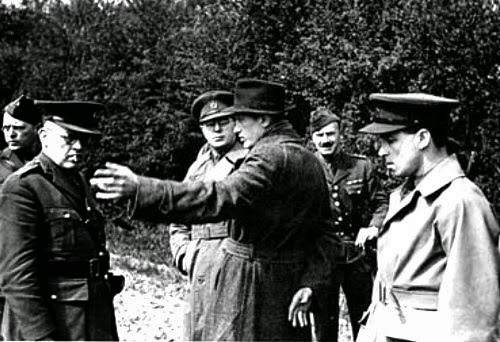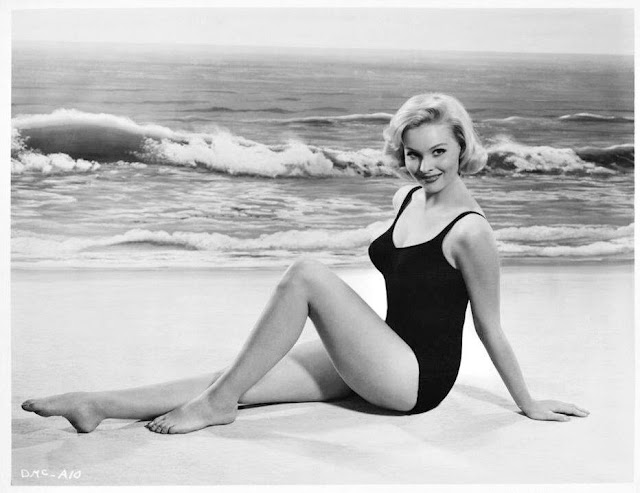Sunday 15 June 1941
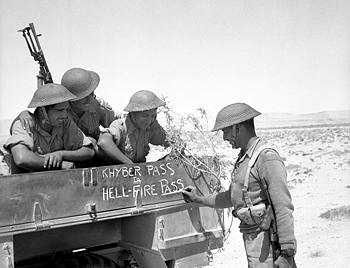 |
| Soldiers of the 4th Indian Division decorate their truck during Operation Battleaxe, North Africa. 15 June 1941. "Hell-Fire Pass" is the common British nickname for Halfaya Pass. |
The Battle of Kissoué begins at 04:00 when 5th Indian Infantry Brigade troops (Brigadier Wilfrid Lewis Lloyd) begin a frontal assault on the town, which is a key stop on the road to Damascus. By 08:30, the Indian troops take the town, and by 09:00, they are probing the hills beyond. By 10:00, the Indian troops have taken Tel Kissoué slightly further north, and Free French marines occupy Mokelbe on the river along the flank. The Free French forces then advance across the river into the hills beyond and take Jebel Kelb, but then run into determined Vichy French resistance at Jebel Abou Atriz just beyond. An artillery battle develops on the extreme right flank, stopping a sortie by Free French tanks. A large Vichy French force then sorties out of Damascus, and other Vichy French advance from the east and take Ezraa.
Brigadier Lloyd then decides that the best defense is a good offense. He sends two companies of Free French troops to the south to hold the Vichy French advancing from the east and orders the Indian brigade to march on Damascus. The Indian troops make some ground, taking Aartouz on the left flank and severing Vichy French lines of communication. As the day ends, the entire sector is in the midst of a wild melee with no clear winner and pockets of troops of both sides scattered in the hills to the south of Damascus.
At Merdjayoun (Merjayun), the Vichy French attack the Australian troops who have been left behind while the main forces moves toward the coast. The French recapture Merdjayoun, but lose a number of their Renault R35 tanks to British 25-pounder anti-tank guns. The French advance stalls after this. Another French counterattack at Jezzine is beaten off.
Overhead, French Dewotine D.520 fighters bounce six Gloster Gladiators above Kissoué and shoot one Gladiator down (Fl-Off J. N. Craigie) and badly damage another. The French lose two fighters, one of which crash-lands at Rayak airfield and is destroyed.
Offshore, Vichy French destroyers Guephard and Valmy once again sortie out of Beirut Harbor. They run into Royal Navy destroyers HMS Jervis and Kimberley, and after a brief fight, the French destroyers retreat back into the harbor. Vichy French bombers attack light cruisers Phoebe and Leander and destroyers Ilex, Isis and Hasty while they are bombarding Sidon. Isis is damaged by a near miss and proceeds to Haifa, and thence to Singapore until 1942.
European Air Operations: RAF Bomber command sends 23 aircraft on anti-shipping missions. RAF Bomber Command also sends 35 bombers to the oil refinery at Hamburg, with 26 reaching the target. After dark, another 91 aircraft attack Cologne, 31 attack Dusseldorf and 16 bombers attack Hannover.
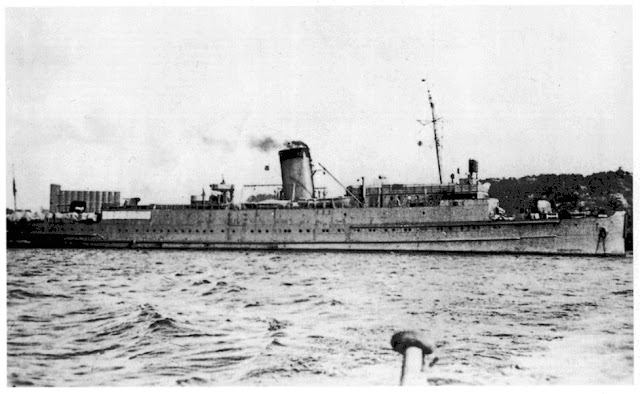 |
| German tanker Lothringen, captured 15 June 1941. |
Acting on Ultra intelligence, Royal Navy submarine HMS Thunderbolt conducts a rare attack on another submarine. It fires a six-torpedo spread at U-557 (Oblt. Ottokar Paulssen), but all six torpedoes miss. U-557, operating with Wolfpack West, never even notices. The two submarines will meet again on 15 December 1941, incidentally, with the tables turned.
The RAF bombs and sinks Danish freighter Hans Broge about 15 nautical miles (28 km) southwest of Texel, Northern Holland. The Hans Broge is later refloated and used for target purposes.
British 7-ton fishing boat Audacious hits a mine and blows up in the Thames Estuary south of Great Wakering. There is one survivor.
U.S. Navy Task Force 3, under command of Rear Admiral Jonas H. Ingram, begins patrol operations from the Brazilian ports of Recife and Bahia. The force consists of four Omaha (CL 4)-class light cruisers and five destroyers.
Convoy OB-336 departs from Liverpool.
Transports 26,454-ton USS West Point (Captain Frank H. Kelley, Jr., Ap-23, formerly liner America) and 33,560-ton Wakefield (AP-21, formerly liner Manhattan) are commissioned.
At 05:15, Brigadier Reginald Savory leads Coast Force toward Halfaya Pass. His force has Halfaya Group (2nd Battalion Queen's Own Cameron Highlanders, the 13 tanks (twelve Matildas and one light tank) of C Squadron, 4th Royal Tank Regiment) on the escarpment overlooking the pass. Advancing from the east are the 1st Battalion 6th Rajputana Rifles and 2nd Battalion 5th Mahratta Light Infantry, two troops of A Squadron, 4th Royal Tank Regiment and a few 25-pounder guns.
Opposing them in Halfaya Pass are 15th Panzer Division and assorted German and Italian infantry. British artillery fails to correctly position itself in time to launch a preparatory bombardment, so the British tanks attack at the top of the pass without artillery support at 06:00. The forewarned German and Italian troops - the Germans intercepted news of the offensive from careless Australian wireless transmissions before midnight - quickly open up with anti-tank fire that knocks out all but one of the advancing British Matilda tanks and one light tank.
The German troops respond quickly with a counterattack led by armored cars and motorized infantry in Halfaya Pass. At Fort Capuzzo, the British 7th Royal Tank Regiment has early success, but 8th Panzer Regiment of the 15th Panzer Division launches several counterattacks that the British tank regiment and 22nd Guards Brigade blunt with great difficulty. The British wind up with Fort Capuzzo. Rommel, however, is keeping the bulk of the 15th Panzer Division back for defensive purposes.
 |
| A map diagram of Operation Battleaxe, 15-17 June 1941. |
However, when all is said and done, the British overall score minor gains along the frontier during the and take over 500 German and Italian prisoners. The British now hold Fort Capuzzo, but fail to take Halfaya Pass and Hafid Ridge.
The British problem is not their minimal gains, but their very real losses in armor and infantry. They have lost dozens of tanks, with the 2nd Royal Tank Regiment down to 20 cruiser tanks and the 6th Royal Tank Regiment down to 20 out of its original 50 Crusader tanks. The 4th Armoured Brigade winds up with only 48 of its starting allotment of 100 tanks (after 11 are repaired overnight). Perhaps just as importantly, the Germans chase the British off the battlefield and prevent the British from recovering their damaged tanks, of which there are many. Among the British tank losses is that of Major Miles, the Commander of "C" Squadron.
The British learn the expensive lesson that their tanks are no match for German 88 mm guns. The Matildas and others also are out-ranged and outgunned by the panzers, and many of the British shots bounce off the panzers' armor. Panzer shells, however, have little trouble destroying British tanks.
Overhead, Luftwaffe I./JG 27, 7./JG 26 and 8./ZG 26 shoot down eight Hawker Hurricanes and two bombers at a cost of two Bf 109s.
The biggest lesson from the first day of Operation Battleaxe, though, is the importance of knowing when your opponent is going to attack. This is a luxury that the British usually have due to Ultra, but in this instance, the tables are turned and the Germans and Italians are the ones who know the enemy's intentions. This enables the Germans to position and man their anti-tank guns along projected axes of the British advance and implement tactics to draw the British tanks into kill zones. The British, incidentally, generally are in the dark about Rommel's intentions because he operates independently from OKW in Berlin and often communicates with his troops directly or via messengers.
The British plan to resume their offensive on the 16th. General Rommel, on the other hand, brings up his 5th Light Division to Sidi Aziz during the evening and night and plans an attack on the advancing British from the rear in order to loosen the stress on the Axis troops defending Halfaya Pass. He orders them to attack before dawn, along with a frontal attack on Fort Capuzzo to pin down the leading elements of the British advance, because he knows from intercepts that the British intend to attack just after dawn.
Elsewhere, in a classic demonstration of the durability of Catalina flying boats, one flying near Gibraltar fights off four Axis planes. The attackers lose one plane, which crashes in Portugal.
General Ritchie takes up his position as Deputy Chief of Staff of the Middle East Command.
Spy Stuff: The US government arrests Japanese naval officer Itaru Tachibana and Charlie Chaplin's former valet, Toraichi Kono for espionage. It is a joint operation by the FBI and Office of Naval Intelligence, and evidence is obtained via a break-in of the Japanese consulate in San Francisco. This becomes known as the "Tachibana Affair." The raid yields a large amount of evidence that effectively destroys the Japanese espionage network on the U.S. West Coast. The US agents, led by Lt. Cdr. Kenneth Duval Ringle, learn to their surprise that the Japanese agents look down on American Japanese as cultural traitors who are not to be trusted.
Axis Relations: The Independent State of Croatia (Nezavisna Država Hrvatska, or NDH) becomes the final country to sign the Tripartite Pact. While nominally an independent nation ruled by the Duke of Savoy, Ante Pavelić controls the country. There now are nine signatories of the Pact, including Germany, Italy, Japan (the original three), Hungary, Romania, Slovakia, Bulgaria, and Yugoslavia. The Soviet Union has asked to join the Pact, but Germany has ignored them. Germany does want Finland to sign, but the Finnish Government knows that signing it would produce a crisis in relations with the United States (with which it is never at war).
Anglo/US Relations: Winston Churchill sends President Roosevelt a cable warning that the Japanese are preparing an attack toward the southern Pacific sometime later in the year. Churchill asks Roosevelt to station warships in Singapore in order to deter a Japanese attack there, which, all things considered in light of later developments, is not such a bad idea.
Italian/Hungarian Relations: Italian Foreign Minister Count Galeazzo Ciano informs the Foreign Minister of Hungary that the Soviet Union is poised to attack Hungary. Neither man knows about Operation Barbarossa, though there is a possibility that their national leaders do to one extent or another.
German Military: Wehrmacht troops continue assembling in their forward positions for Operation Barbarossa. U-boats in the Baltic are given permission to begin attacking any Soviet warships they spot - but there aren't very many of those at sea. These sinkings, if there are any, are to be excused as "accidents." This is reminiscent of the Kriegsmarine ordering its U-boats to sea on 15 August 1939 in preparation for the attack on Poland.
US Military: The US Navy commissions its new Naval Air Station (NAS) at Kodiak, Alaska. This NAS in the Aleutian Islands has been under construction since September 1939. It is to become home to PBY patrol squadrons which patrol 4,000,000 square miles covering the Gulf of Alaska, Bristol Bay, the Bering Sea, and Alaska's Pacific coast.
General Miles Dempsey takes command of the 46th Infantry Division.
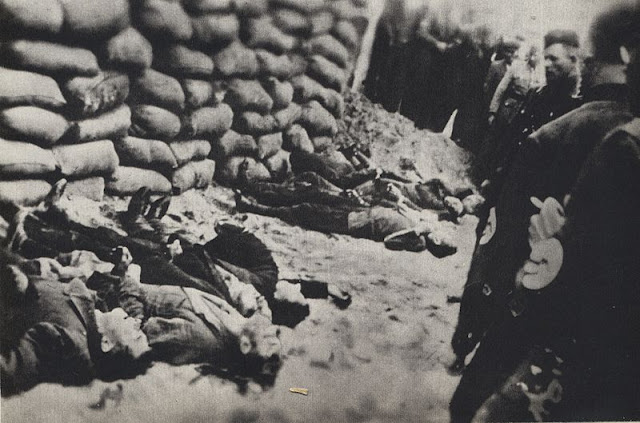 |
| German troops execute 10 Polish hostages in German-occupied Gąbin, 15 June 1941. |
Hitler, for all his confidence, is having trouble falling asleep. He spends the early morning hours rambling with his attentive minions. This is a pattern that will recur frequently in the coming months, and at times become his daily habit. His personal physician, however, has sedatives for when he really needs some rest.
China: The Japanese bomb Nationalist capital Chungking (Chongqing) again. US gunboat USS Tutuila (PR-4) is docked in the river and some bombs land nearby. Some slight damage to the US Embassy there results. After the US files a diplomatic protest, Japanese Admiral Shimada Shigetaro issues an apology and tells the Americans that it was "not intentional." The US also complains in general about Japanese raids on the civilian population of Chungking.
Holocaust: In German-occupied Gąbin, Poland, German troops stage a public execution of 10 Polish hostages.
American Homefront: Reflecting a pessimistic tone to many commencement speeches this year, James B. Conant, President of Harvard University and recently head of a mission to Great Britain on behalf of President Roosevelt, says to the graduating class of Harvard:
It is conceivable that the next fifty years for the United States will be as black as the last year has been for France.He also somewhat cheerlessly notes that the Draft will cause "for most of you some frustration of your ambitions."
Future History: Harry Edward Nilsson III is born in Brooklyn, New York. He becomes a top recording star during the 1960s and 1970s, having big hits with albums Nilsson Schmilsson (1971) and Son of Schmilsson (1972). He also is known for being close friends with John Lennon and Ringo Starr. Harry Nilsson passes away on 15 January 1994 at age 52.
Neal Adams is born on Governors Island, Manhattan, New York. He becomes a top comic book and commercial artist, working for DC Comics and Marvel among others. He creates the definitive portrayals of characters Batman and Green Arrow. As of this writing, Neal Adams continues to work on various projects, including a "Deadman" limited series.
 |
| Essy Persson becomes a Swedish film star. |
 |
| German soldiers on leave in East Prussia, 15 June 1941 (Federal Archive N 963 Bild-14-12A). |
June 1941
June 1, 1941: Farhud Pogrom
June 2, 1941: Massacres on Crete
June 3, 1941: Kandanos Massacre
June 4, 1941: Kaiser Wilhelm Passes Away
June 5, 1941: Death in Chungking
June 6, 1941: Hitler's Commissar Order
June 7, 1941: Commandos Strike at Pessac
June 8, 1941: British Invade Syria and Lebanon
June 9, 1941: Litani River Battle
June 10, 1941: British Take Assab
June 11, 1941: Hitler Thinking Beyond Russia
June 12, 1941: St. James Agreement
June 13, 1941: Lützow Damaged
June 14, 1941: Latvian June Deportations
June 15, 1941: Operation Battleaxe
June 16, 1941: The Old Lion
June 17, 1941: British Spanked in North Africa
June 18, 1941: Turkey Turns Its Back
June 19, 1941: Cheerios Introduced
June 20, 1941: Birth of US Army Air Force
June 21, 1941: Damascus Falls
June 22, 1941: Germany Invades Russia
June 23, 1941: A Soviet KV Tank Causes Havoc
June 24, 1941: Kaunas and Vilnius Fall
June 25, 1941: Finland Declares War
June 26, 1941: Bombing of Kassa
June 27, 1941: Encirclement At Minsk
June 28, 1941: Minsk Falls
June 29, 1941: Brest Fortress Falls
June 30, 1941: Mölders Becomes Top Ace
2020








